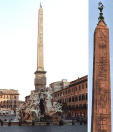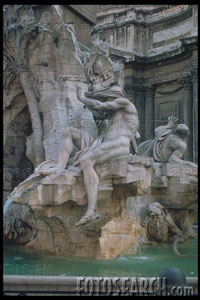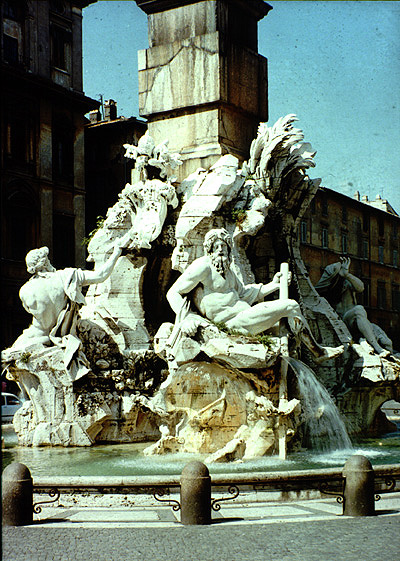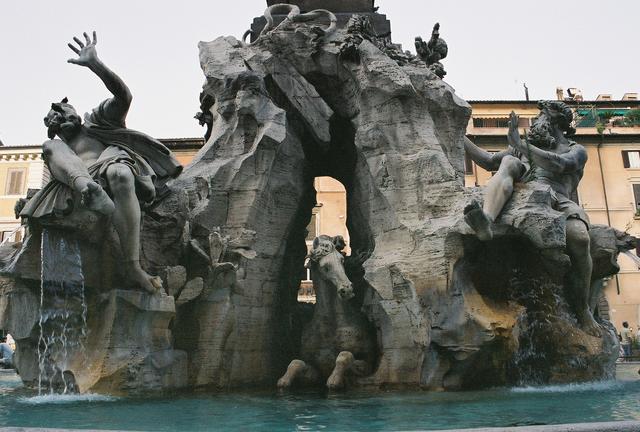|
|
 |
|
Bernini's Four Rivers Fountain |
|
written
by acz / 09.13.2004 |
|
|
| |
Description |
| |
| |

|
| www.romeartlover.it/ Vasi26na.html |
| Four Rivers obelisk |
| The obelisk was cut in Egypt and brought to Rome by Domitian. The hieroglyphics were carved by order of Domitian, and refer to him as 'eternal pharoah' and to Vespasian and Titus as gods. The obelisk had lain for centuries in the Circus Maximus until Innocent X decided to use it for his fountain. |
| |
|
| |

|
| www.public.asu.edu/ ~jfschum/italy/misc/it107.html |
| Bernini's lion and palm tree |
| Of these two figures, the palm tree is particularly engaging, in that it appears to be caught in some warm, tropical breeze. |
| |
|
| |

|
| www.fotosearch.com/ CPH188/224014/ |
| The Nile |
| The depiction of a river god with his head covered was a common way to convey that a river's source was unknown. |
| |
|
| |

|
| www.uic.edu/.../ahaa/ classes/ah111/L19/19-14.jpg |
| The Ganges |
|
| |
|
| |

|
| www.greatestcities.com/.../ Italy/Lazio/Rome/ |
| The Plata, Danube, and horse |
| The Plata is the god sheilding his eyes and the Danube is shown on the right. This picture also illustrates (somewhat) the 'hollow' appearance of the grotto. |
| |
|
The fountain is surmounted by an obelisk made of red oriental granite, crowned with a dove and olive branch, symbols of peace, the Holy Spirit, and the Pamphili family. The obelisk is supported by a rocky base of white granite (travertine). The pieces of the base are put together to form a kind of arch, creating a grotto with four openings. The openings give the obelisk the illusion of resting upon nothing, an accomplishment admired by many of Bernini's comtemporaries. It is said that because of this illusion of weightlessness, many of his critics claimed that the obelisk was not adequately supported and might fall. In response, Bernini supposedly tied thin strings from the obelisk to the surrounding buildings in a mocking salute to his critics' concerns.
Sitting on the base are the figures of four reclining river gods, meant to represent the four major continents: Europe, Asia, Africa, and the Americas. Each god is surrounded by fauna and flora meant to help identify his respective continent. The Nile, representing Africa, has his head covered by a shroud, representing the fact that the source of the river had been unknown for so long. He is surrounded by a lion and palm tree. Asia is represented by the Ganges. He holds an oar, signifying the great extent and navigability of the river’s waters and is accompanied by a serpent. The Rio de la Plata represents the Americas. Next to him lie coins symbolizing the riches of that continent and an armadillo-like creature. Lastly, Europe is represented by the Danube, who is holding up the papal arms and is accompanied by a horse. It is believed that Bernini carved the rock, palm tree, lion and horse, and that everything else was done by Bernini’s assistants, according to his designs. The Danube was carved by Antonio Raggi; The Nile by Giacomo Antonio Fancelli; The Ganges by Claude Poussin; and the Plata by Francesco Baratta.
* * * *
The fountain personifies the Baroque in its depiction of life and movement. Bernini is able to create the impression of pulsating life and real movement through the illusory movement of the carvings and the rushing, murmuring water. The limbs of the gods project into their surrounding space and their intense facial expressions and tousled locks give them the impression of impassioned movement. There are also elements of contrast, a device characteristic of the Baroque sculpture: the tons of marble of the obelisk versus its impression of apparent weightlessness; and the expansive variance of the bottom versus the hard, uniform, and thin apex.
|
| |
|
| |
|
|
 |
|





